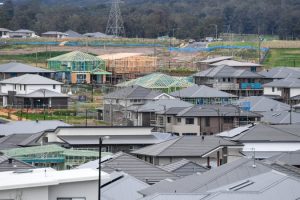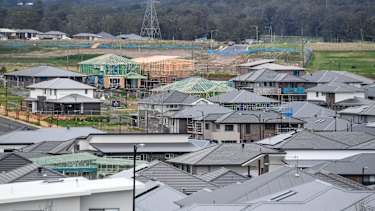Mortgage shock: Your monthly repayments could be $1300 higher by next year

Homeowners face big increases in their monthly mortgage payments in coming months, on top of a soaring cost of living, which will put many household budgets under severe financial pressure.
If official interest rates rise to 2.5 per cent by the middle of next year – which many economists are forecasting – monthly repayments on a $1 million mortgage would rocket by more than $1300.
Repayments on variable rate mortgages are likely to keep rising until the middle of 2023Credit:Peter Rae
The Reserve Bank of Australia (RBA) is almost certain to follow last month’s increase in the cash rate with another this week, turning the screws on variable-rate mortgage holders, as their lenders pass on the equivalent extra impost to their repayments.
An expected 0.25 percentage point increase on Tuesday would increase monthly repayments on a $1 million variable-rate mortgage by $138, figures from Canstar show. That is in addition to the $103 increase in May, after the RBA lifted the cash rate for the first time in 11 years – from 0.1 per cent to 0.35 per cent.
The vast majority of lenders – including all four major banks – passed through the May rate rise in full.
There is even a chance the RBA could lift official rates by more than 0.25 percentage points this time around if it feels more needs to be done to curb runaway inflation.
Canstar figures show $222 would be added to the monthly mortgage repayments if the central bank were to increase the cash rate by 0.4 percentage points, to take the cash rate to 0.75 per cent.
If official rates keep rising until reaching a peak of 2.5 per cent, monthly repayments on a $1 million mortgage would rise by $1361.
Canstar’s figures make several assumptions, including that the homebuyer has 20 per cent equity in their property and the loan term is 30 years.
Independent economist Saul Eslake is expecting a 0.25 percentage point rise in the cash rate on Tuesday.
“I don’t think it will have any appetite to do more… as the RBA thinks our inflation problem is not as bad as in other countries,” he says.
“I think that the ‘terminal’ cash rate will be somewhere between 2 per cent and 2.5 per cent,” Eslake says. “And I expect the RBA to get there by the second quarter of next year,” he says.
Shane Oliver, chief economist at AMP, says while the RBA would continue increasing official rates, the “negative wealth effect” from the resulting fall in house prices would likely slow household spending, taking some heat out of rising inflation.
Some property market watchers, including Oliver, are expecting dwelling prices to fall by up to 15 per cent, peak-to-trough.
“The fact that [dwelling] prices are already starting to fall tells us that rate hikes are getting traction, suggesting that [the RBA] may not have to raise rates as much as would otherwise be the case,” Oliver says.
That means the peak cash rate could be 2 per cent, rather than the 3 per cent or more that financial markets are predicting, he says.
Mortgage borrowers seeking protection from higher variable-rate loan repayments by switching to fixed rates appear to have missed the boat. Lenders have already increased their fixed rates substantially.
Sally Tindall, research director at RateCity, says a year ago the average big-four bank 3-year fixed rate was 0.68 percentage points below than their lowest average variable-rate mortgage, but it is now 2.57 percentage points higher.
However, there are still some attractive fixed rates up for grabs, particularly if the cash rate does not rise as high as some economists are forecasting, Tindall says.
Most Viewed in Money
From our partners
Source: Read Full Article

